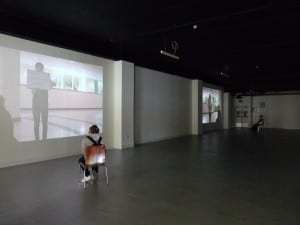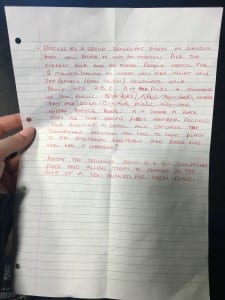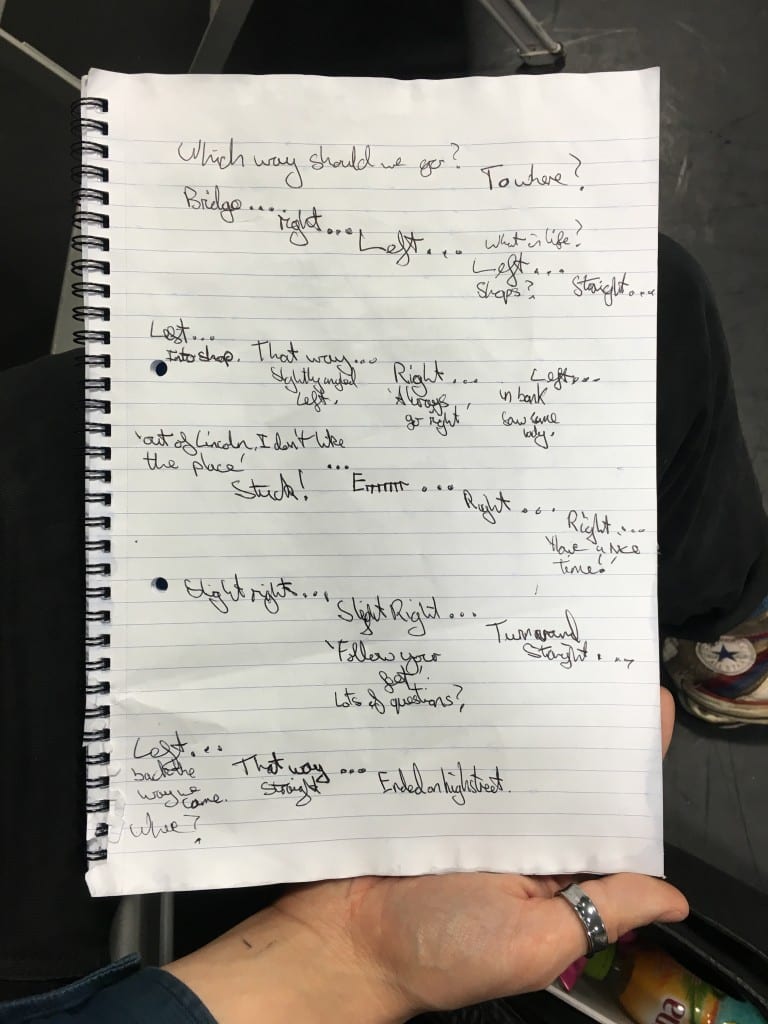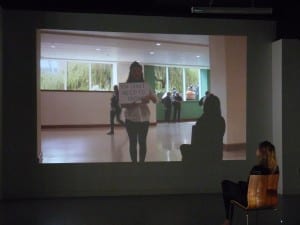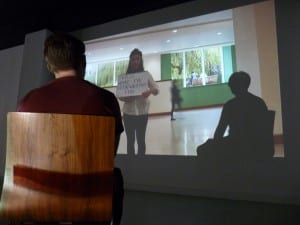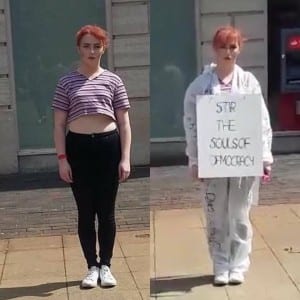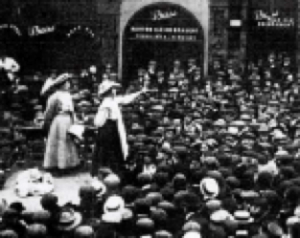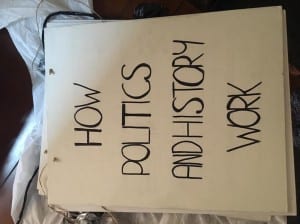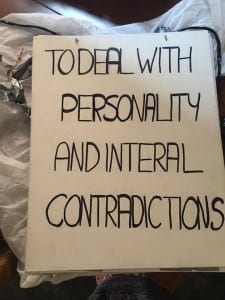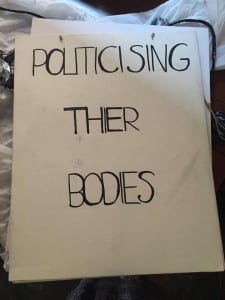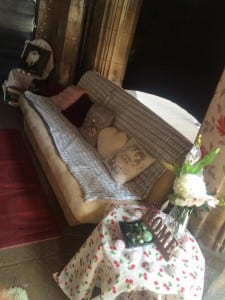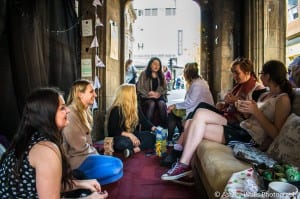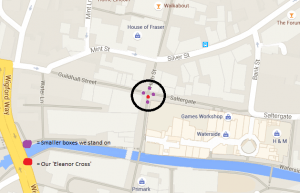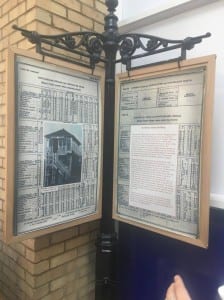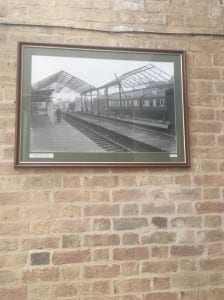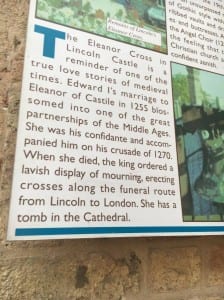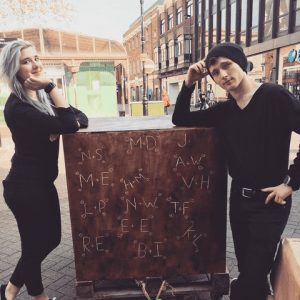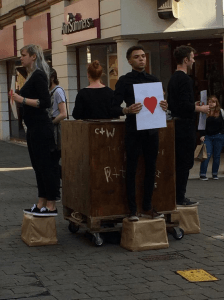Framing Statement:
On Friday the 6th of May 2016 Myself, Laura Potente and James Crawford performed a durational site specific performance in the bottom unit of the waterside shopping centre. The performance was titled ‘Inbetween’ and began at 11:30am and finished at 4:30pm, our performance involved a multitude of technology inside the unit. The layout of the empty unit was that of a shop, two large glass windows facing out with a large entrance between them facing the shopping centre and multiple pillars within the space. We placed two monitors inside the shop and behind the glass facing outward, then we placed two cameras facing the same way but connected them up with a live feed. This way audience members and passers-by could see themselves in the frame of the camera on the screen and we as performers could see ourselves. Then we placed two larger wider lensed cameras next to the previous cameras again one on each side of glass and connected these larger cameras to two projectors placed at two different points of the space. The projectors were connected via a live feed and displayed on two sections of the white wall inside the space, and showed the same image of the smaller cameras. Then three chairs were placed inside the space, one in front of each projection and these chairs were for audience members to sit and watch the conversation that the performers did (See Fig.1) . The third chair was for the Usher and that was placed in the entrance of the space.
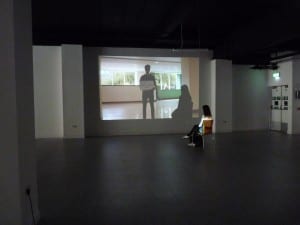
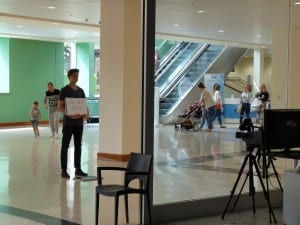
As performers we operated in a shift like manner, at all times there would be two performs outside within frame of the camera and the other performer would have a job role similar to an Usher, they would be free to move around the space with tasks such as: Checking battery life on the cameras and changing them if necessary, inviting audience members into the space and guiding them and making sure projections are correct and performers are in frame. The two performers outside each had two card pads, pad A and pad B each containing a different conversation. The process of our performance went as such, the usher invited audience members in and guided them to the chairs if it was a group the usher would pick two people and again guide them to the chairs. The usher would then sit in their chair and signal for the performers to begin, conversation A would start and when it finished the usher would ask the audience members to swap chairs then the usher would sit back down and conversation B would start and when that finished the audience were asked to leave and then on of the performers would swap with the usher and would so repeat.
Our performance allowed the audience who were shoppers within the centre who were always moving and busy, to sit down and take a break. Shopping is built upon the process of transaction,you give something in exchanged for something back, it has and always will be about that exchange and that’s what our performance truly highlights and shows the audience. It’s a chance for them to give us their time and for us to give them our words. The performance that we achieved at the end of our process was inspired and developed by exploration and experimentation we had developed the piece and then deconstructed it when finding out it didn’t fit “Generated through trial and error, through improvisation and the testing of proposals over a protracted period” (Pearson, 2010) We would take small pieces that we have previously and attempted again and eventually we ended up with a performance much simpler but more creative than we had at first.
Analysis of Process:
Right from the beginning we wanted to begin performing practically and experiment, our first was to go out of the LPAC building and at every left and right turning we would ask a passer-by what direction to go in. and then continue in the direction given until we found another turning and then would ask another member of the public, we noted each turning and by the end had created a map of our journey (See Fig.2). This experiment had taken a lot of inspiration from the piece of work Navigating the everyday by Daniel Belasco Rogers and Sophia New (See Fig.2), this performance involves the two of them recording their everyday journey using GPS devices and recording their moods at certain times, finally creating a map of their journeys. “This mood diary enables them to compare their emotional life with the GPS traces of their movements and collected text messages” (Lutz, 2016) We really liked the idea of the mapping out what we explored, our experiment took a different turn than this project, we wanted to embrace the unknown and explore our map through chance and this later evolved into our theme of surveillance.

Our second experiment took place the week after and like the first one was based upon Navigating the everyday the three of us went down to the Ritz at the bottom of the high street and drew a continuous line of chalk all the way up to the British heart foundation (See fig.3). One person drew the line of chalk, another used a sweeping brush and cleared the pathway in front of the drawer and the other filmed and held a sign saying ‘Is this a test?’ This experiment in our eyes meant that the brush was sweeping a clear and clean pathway, the chalk line was the physicalization of the route or road being constructed and the chalk board and filming was the documentation. During the experiment many members of the public asked us questions and became quite interested with what we were doing, people asked what it meant and where we were drawing up to and we loved how people stopped and watched. The most interesting thing was when we filmed walking back to the spot we first started, no one looked down at the line or questioned why it was there and we gathered that when people watched this line being created it drew attention and people questioned but after we had finished it became mere nothingness to the public and merely left a mark on the floor.
Fig. 3 Site Specific: Chalk experiment (Sargent Elliot, 2016)
The week after myself and Laura went to watch Andrew Westerside’s company Prototype perform their new piece of work A Machine they’re secretly building this had major themes of surveillance, conspiracy and people rights of information. We instantaneously became inspired and majorly influenced by this piece of work and went around the streets of Lincoln and realised how many security cameras there are, we then had the idea of taking photographs of all the CCTV cameras that we could see and perhaps make a map of Lincoln and mark each point where a camera had been stationed similar to how the Mood diary by Daniel Belasco Rogers and Sophia New highlighted points on map where their moods changed. We also saw a few articles online about new cameras being developed that could target members of the public that could be threat to people’s safety based on their ethnicity and if they had any erratic behaviour for example running or shouting in a public space. By deepening our research into these cameras we found votes for these cameras to be installed within universities over the country and we originally wanted members of the public to be aware of these issues. The reasoning behind creating a map was our chance to show and raise awareness of just how many cameras are placed around Lincoln, for the audience to see the statistics and locations not to make them fearful or anxious but to make them remember they are being watched and recorded.
It was now time for the three of us to finally find a location that we felt would be suitable for the ideas gathered, we eventually though of an empty unit in the bottom of the waterside shopping centre. After getting into contact with the Waterside shopping centre we found the space was not functional, it had no running electricity and no working lights. It was at that point we managed to acquire the other empty unit in the centre, this was essentially a large white space which provided many opportunities (See Fig.4)
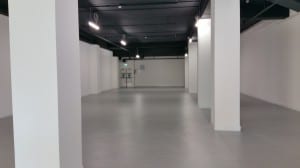
It was now time to show the rest of our group an idea that we had created, so we got our group involved with an experiment this involved them going to different parts of the shopping centre and myself, laura and James being recorded on an smartphone application called Facebook Live. The application allowed us to broadcast online a live video (See Fig.5), we then held a sign saying ‘ANY REQUESTS’ and allowed the online spectators to comment and ask us to perform actions some involved perform star jumps or randomly burst into song. This was a unique way for us to see how an audience would react if they were watching a performance and not in the space, and what they thought of watching a performance through a screen in a completely different location but knowing that it was live. We had very positive reactions online and in person, we had comments saying that it felt like a great way for people at home or in another country to watch a performance and try and piece together what was happening without knowing the context behind it.
https://www.youtube.com/watch?v=0Z_ZjEAzWtM&feature=youtu.be
Fig. 5 Facebook Live experiment (Potente Laura, 2016)
Our next step was the creation of our shop, the three of us wanted to transform the space into a shop. We had an empty unit inside the bottom of a shopping centre, between two shops which resulted in being the perfect location to create one. Our shop was layed out in Figure 3 (shop layout photo) four main sections, Confessional, archive, shopping area and the blacked out room. From the beginning all three of us became very interested in Adrian Howells piece Salon Adrienne this transactional performance where “Adrienne offered each visitor a shampoo and head massage as well as asking questions far more profound than where you plan to go on your holidays” (YouTube, 2016) was interesting and we inserted our own exchange the shoppers would come into the confessional space and tell us something about them and we would take a part of their body e.g. a toenail or a strand of hair and place it in our other section which was the archive this was our version of the exchange which was physical. The shopping area was comprised with a desk with a till and several racks filled with hangers, the hangers held photographs of security cameras and restricted places, we sold these as free. This was what we believed worked for our shop, a completely minimalist shop selling photos of restricted places for free and simply taking an email address as payment barely giving the shoppers information and meaning.
Evaluation:
Our plan for the performance on the day was to gather our equipment from the LPAC early and arrive as soon as possible at the space to begin setting up and preparing the space, our goal was to begin the performance at 11:30am. Our assessed performance would be at around 2pm so between 11:30am and 2:30pm was our chance to practice with the public, to see how they would react and how we would perform. This was our most difficult and stressful time, before this we had not had an opportunity to use the equipment and fully see what our layout and the space would look like with the projectors, cameras and monitors. One problem that we found early on is that the projections were not as clear and crisp as we hoped, outside the lights were very bright and they bled onto the inside causing problems with the image so in hindsight we could have improved by testing smaller projectors and seeing how well they performed. Our biggest difficulty arrived the day before, one of the staff running the shopping centre went back against their word saying we could not move a display in the front of the space and we originally thought that would severely impact the performance but on the day of the performance we all saw that it in actual fact it worked in our favour. It gave the image of our space trying to be a shop but not actually being a shop, being in the same space as a shop, and having products and mannequins displaying items that of course would normally be found in a retail shopping environment but juxtaposed our white box space.
We managed to set up quickly and were on time and ready to perform at 11:30am, at first we found it difficult to attract people to come in but after a few fellow students came in the general public became influenced and interested. Many people responded well and were very curious about what our performance meant and why it was chosen in that location. We had a particularly interesting response from audience members, one member even said it truly evoked a connection with them and the child they were with. One of our strongest elements within the performance came out of chance on the day of the performance, we placed both chairs between the projector and the projection and created an interesting image of the spectator being within the frame and almost coming into contact with the performer (See Fig.6).I have been looking at CREW who are a Belgian-based company who have creative and immersive uses for technology and they say “Technology seems to have a conceptual and symbolic layer, while at the same time it can be used as a very instrumental, pragmatic, material thing to obtain a certain goal” (Nedelkopoulou et al., 2014) and after reading some of their articles I feel that if we did the performance again we could incorporate the spectators shadow for example When we show the board ‘I wish we could hold hands’ the performer could reach to the shadow of the spectator through the camera, this immerses the spectator even more and brings them much deeper into the performance and would potentially encourage them to reach out and then they themselves would be a part of the piece.
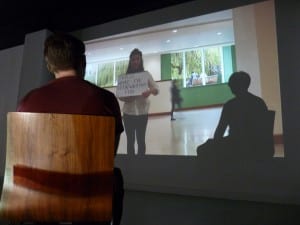
Conclusion:
I have extremely enjoyed my time over this module and am very proud of the performance we created, I feel the this unit within the waterside shopping centre is a brilliant space for site specific given the amount of pathways it presents.
I feel that we as a group we have created an engaging and connecting performance that made effective use of such a big and simple space, there are still many ways we could have developed it but I feel it was a welcome change to visitors and shoppers at the waterside shopping centre. From studying this module my creative knowledge has been broadened and my thoughts and ideas have been extended.
Bibliography:
Lutz, A. (2016). artlaboratory-berlin.org – planb – Navigating the Everyday. [online] Artlaboratory-berlin.org. Available at: http://www.artlaboratory-berlin.org/html/eng-exh-25.htm [Accessed 13 May 2016].
Nedelkopoulou, E., Joris, E., Bekaert, P. and Vanhoutte, K. (2014). On the border between performance, science and the digital. International Journal of Performance Arts and Digital Media, 10(2), pp.246-254.
Pearson, M. (2010). Site-specific performance. Houndmills, Basingstoke, Hampshire: Palgrave Macmillan.
Potente, L. (2016). live. Available at: https://www.youtube.com/watch?v=0Z_ZjEAzWtM&feature=youtu.be [Accessed 13 May 2016].
Sargent, E. (2016). Site Specific: Chalk expriment. Available at: https://www.youtube.com/watch?v=i8B4XnAQjjc&feature=youtu.be [Accessed 13 May 2016].
YouTube. (2016). Salon Adrienne- Adrian Howells. [online] Available at: https://www.youtube.com/watch?v=M7XcWo2GzSo [Accessed 13 May 2016].
